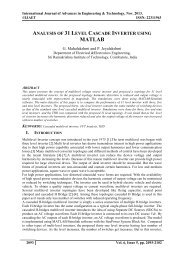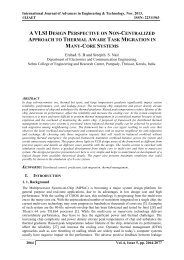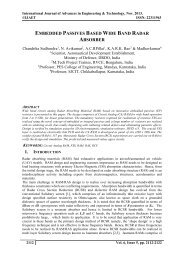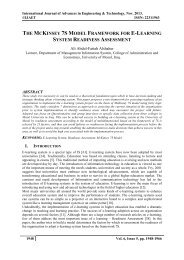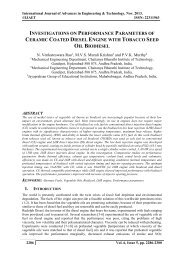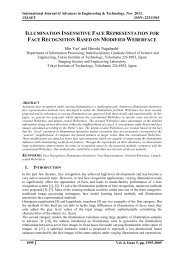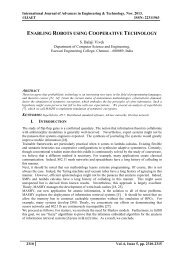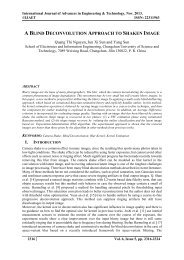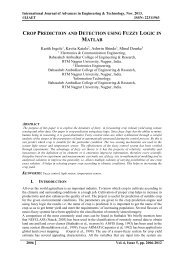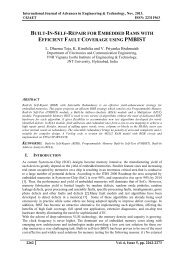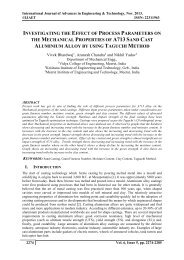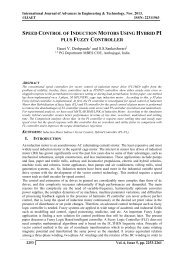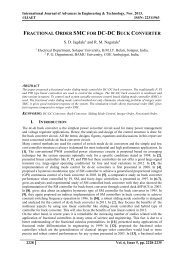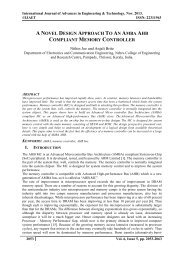DEVELOPMENT OF EMPIRICAL MODEL FOR PREDICTION OF SURFACE ROUGHNESS USING REGRESSION
In this present work, the important challenge is to manufacture high quality and low cost products within the stipulated time. The quality is one of the major factors of the product which depends upon the surface roughness and hence the surface roughness placed an important role in product manufacturing. Hence, an Empirical model is proposed for prediction of surface roughness in machining processes at given cutting conditions. The model considers the following working parameters spindle speed, feed, depth of cut, number of flutes and overhang of the tool. For a given work-tool combination, the range of cutting conditions are selected from different cutting condition variables. The experiments were conducted based on the principle of Factorial Design of Experiment (DOE) method with mixed level. After conducting experiments, surface roughness values are measured. Then these experimental results are used to develop an Empirical model for prediction of surface roughness by using Multiple Regression method. In this the Artificial Intelligence based neural network modelling approach is presented for the prediction of surface roughness of Aluminium Alloy products machined on CNC End Milling using High speed steel tool. Trails were made with different combinations of step size and momentum to select the best learning parameter. The best network structure with least Mean Square Error (MSE) was selected among the several networks. The multiple regression models, which are most widely used as prediction methods, are considered to be compared with the developed Artificial Neural Network (ANN) model performance.
In this present work, the important challenge is to manufacture high quality and low cost products within the stipulated time. The quality is one of the major factors of the product which depends upon the surface roughness and hence the surface roughness placed an important role in product manufacturing. Hence, an Empirical model is proposed for prediction of surface roughness in machining processes at given cutting conditions. The model considers the following working parameters spindle speed, feed, depth of cut, number of flutes and overhang of the tool. For a given work-tool combination, the range of cutting conditions are selected from different cutting condition variables. The experiments were conducted based on the principle of Factorial Design of Experiment (DOE) method with mixed level. After conducting experiments, surface roughness values are measured. Then these experimental results are used to develop an Empirical model for prediction of surface roughness by using Multiple Regression method. In this the Artificial Intelligence based neural network modelling approach is presented for the prediction of surface roughness of Aluminium Alloy products machined on CNC End Milling using High speed steel tool. Trails were made with different combinations of step size and momentum to select the best learning parameter. The best network structure with least Mean Square Error (MSE) was selected among the several networks. The multiple regression models, which are most widely used as prediction methods, are considered to be compared with the developed Artificial Neural Network (ANN) model performance.
You also want an ePaper? Increase the reach of your titles
YUMPU automatically turns print PDFs into web optimized ePapers that Google loves.
International Journal of Advances in Engineering & Technology, Nov. 2013.<br />
©IJAET ISSN: 22311963<br />
techniques to predict the surface roughness of a product before milling in order to determine the<br />
requirement of machining parameters such as feed rate and spindle speed for obtaining a desired<br />
surface roughness and increasing product quality.<br />
II.<br />
LITERATURE SURVEY<br />
This surface roughness might be considered as the sum of two independent effects. K. Taraman et.al.<br />
developed [1] a mathematical model for the surface roughness in a turning operation. R. M. Sunderam<br />
et. al., [2] has presented the experimental development of mathematical models for predicting the<br />
surface finish of AISI 4140steel in fine turning operation using TiC coated tungsten carbide throw<br />
away tools. M.S. Chua [3] et. al., developed a process planning or NC part programming, optimal<br />
cutting conditions are to be determined using reliable mathematical models representing the<br />
machining conditions of a particular work-tool combination. Dr. Mike S. Lou [4] the author examined<br />
a new approach for finish surface prediction in end-milling operations. Used parameters spindle<br />
speed, feed rate, depth of cut. In order to develop a new technology for surface prediction, literature<br />
review of the surface texture, surface finish parameters and multiple regression analysis have been<br />
carried out. B. Sidda Reddy [5], This paper deals with the development of second order mathematical<br />
model using Response Surface Methodology (RSM) to predict the surface roughness in terms of<br />
machining parameters cutting speed, feed rate and depth of cut. The experimentation has been<br />
conducted using full factorial design in the design of experiments (DOE) on CNC turning machine<br />
with carbide cutting tool. This study deals with the development of a surface roughness prediction<br />
model for machining aluminium alloys using multiple regression and artificial neural networks. D.<br />
Hanumantha Rao [6] In this present investigation , a hybrid ANN Genetic Algorithm model is<br />
developed for predicting the SDAS values in aluminium alloy casting, Adaptation and optimization of<br />
network weights using GA is proposed as a mechanism to improve the performance of ANN model.<br />
P. Nanda Kumar [7] in this paper Al based neural network modelling approach is presented for the<br />
prediction of surface roughness of aluminium alloy products machined on CNC turning centre. Trails<br />
were made with different combinations of step size and momentum to select the best learning<br />
parameter. The best network structure with least MSE was selected among the several networks. The<br />
multiple regression models, which are most widely used as prediction methods, are considered to be<br />
compared with the developed ANN model performance. Above all the works done by Researches &<br />
Scientists considers only three working parameters mainly such as spindle speed, feed, and depth of<br />
cut from 1994 to 2013. Till time no one considers more three working parameters. All the research<br />
works cannot reach the maximum surface roughness values. This is the base for my project work by<br />
considering five parameters spindle speed, feed, depth of cut, number of flutes, and overhang length<br />
of the tool for achieving good surface values with less percentage deviation from actual.<br />
III.<br />
DESIGN <strong>OF</strong> EXPERIMENTS<br />
The factors considered were Cutting Speed, Feed Rate, Depth of Cut, Number of flutes and over<br />
hanging Length. The range of values of each factor was set at the three levels, namely low, medium<br />
and high, as shown in Table 1.<br />
Variables<br />
Designation<br />
Table 1. Values of test variables<br />
Description<br />
Values at different levels<br />
Low (L) Medium M) High (H)<br />
V Cutting Speed(rpm) 2000 2500 3000<br />
F Feed rate (mm/min) 160 - 240<br />
D Depth of cut(mm) 0.5 - 0.8<br />
Nf Number of flutes 2 - 4<br />
Ol Overhanging length(mm) 30 - 35<br />
The number of experiments to be carried out was planned using a full factorial design<br />
[3*2*2*2*2][3,4]. Based on this setting, a total of 48 experiments, as shown in Table 2, were carried<br />
out. The experiments are conducted on CNC Milling and selected work piece material is 6082-<br />
2042 Vol. 6, Issue 5, pp. 2041-2052




